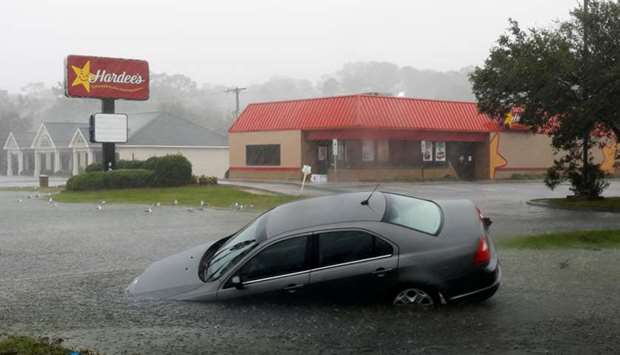* More catastrophic flooding forecast from slow-moving storm
* Florence could drop up to 40 inches (102 cm) of rain
* Efforts underway to rescue stranded people
Tropical Storm Florence dumped "epic" amounts of rain on North and South Carolina as it trudged inland on Saturday, triggering dangerous flooding, knocking out power in nearly 900,000 homes and businesses, and causing at least eight deaths.
Florence's intensity has diminished since it roared ashore along the US mid-Atlantic coast on Friday as a hurricane. But its slow march over the two states, crawling west at only 2 miles per hour (3 km per hour), threatens to leave large parts of the region deluged in the coming days.
"This system is unloading epic amounts of rainfall, in some places measured in feet and not inches," North Carolina Governor Roy Cooper told a news briefing. His state has already endured record rainfall totals, with much more expected to come from the storm that forecasters said was 480 km wide.
"This is a hurricane event followed by a flood event," said South Carolina Governor Henry McMaster.
With flood waters rising rapidly in many communities, stranded people were being rescued by boat and by helicopter, while tens of thousands of others hunkered down in shelters. Numerous roads were closed, and authorities warned of potential landslides, as well the possibility of flood waters imperiling dams and bridges as rivers and creeks swelled.

A man clears a downed tree after Hurricane Florence struck on Wilmington, North Carolina


Utility crews worked to restore electricity even as flood waters inundated whole communities. As of Saturday afternoon, about 752,000 people remained without power in North Carolina, along with 119,000 in South Carolina.
In Wilmington, a city of about 120,000 on North Carolina's Atlantic coastline, along the Cape Fear River that is home to historic mansions, streets were strewn with downed tree limbs and carpeted with leaves and other debris. Electricity remained out for much of the city, with power lines lying across many roads like wet strands of spaghetti.
"The fact that there haven't been more deaths and damage is amazing and a blessing," said Rebekah Roth, walking around Wilmington's Winoca Terrace neighborhood.
Rising rivers
At 2 p.m. EDT (1500 GMT), the hurricane center said Florence had maximum sustained winds near 75 km per hour and continued to produce catastrophic flooding in the Carolinas. It said it was located about 65 km west of Myrtle Beach, South Carolina, and forecasters predicted a slow westward march.
The National Hurricane Center said the storm would dump as much as 76-102 cm of rain on the southeastern coast of North Carolina and part of northeastern South Carolina, as well as up to 25 cm in southwestern Virginia.
Fayetteville, a city of about 210,000 people about 145 km inland, issued a mandatory evacuation order for thousands of residents near Cape Fear River because of flooding. Fort Bragg, a sprawling US Army base, is just west of Fayetteville.
Governor Cooper advised North Carolina residents inland that rivers will rise days after the rain has stopped. Officials said there had been at least seven storm-related fatalities in the state.
Authorities in South Carolina reported one death, saying a woman was killed when her vehicle struck a fallen tree.
Florence already has set a North Carolina record for rainfall totals, exceeding that of Hurricane Floyd, which struck in 1999 and caused 56 deaths. Floyd produced 61 cm of rain in some parts of North Carolina while Florence already has dumped about 76 cm in areas around Swansboro.
On Thursday, Florence was a Category 3 hurricane on the five-step Saffir-Simpson scale with 193 kmph winds. It was downgraded to Category 1 before coming ashore on Friday near Wilmington.
In New Bern, at the confluence of the Neuse and Trent rivers in North Carolina, Florence overwhelmed the town of 30,000, with the downtown area under water. Some area residents described a harrowing retreat as the storm hit.
"It was pitch black and I was just scared out of my mind," said Tracy Singleton, who with her family later drove through torrential rain and high winds from her home near New Bern to a hotel some 130 km away.
More than 20,000 people were in 157 shelters in North Carolina, with nearly 6,000 in South Carolina shelters, officials said.
South Carolina authorities said law enforcement officers were guarding against looting in evacuated areas.
Schoolteacher Leslie Ochoa said she and her family loaded up 10 adults, 5 children, 14 goats, 10 dogs, two cats and one guinea pig and evacuated from Jacksonville, North Carolina to Columbia, South Carolina last Tuesday. As her son fed the goats in a hotel parking lot, she said she might not be able to return home until the middle of next week.
"Our friend behind our old house, they have gators swimming in the water. So yeah, not safe," Ochoa said.
The White House said President Donald Trump approved making federal funding available in some affected counties. Trump plans a visit to the region next week.
As the United States dealt with Florence, a strong typhoon tore across the northern tip of the Philippines, killing at least three people, wrecking homes and triggering landslides before heading toward Hong Kong and southern China.



